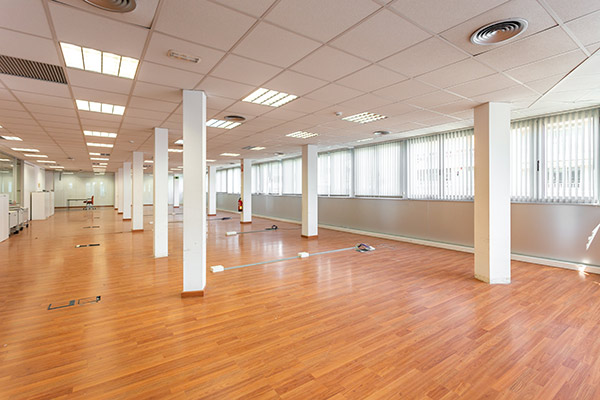What Do Empty Office Buildings Mean for the Economy?

As office workers continue to work from home post-pandemic, office buildings throughout the country remain partly empty. Global real estate services company Jones Lang LaSalle (JLL) reports that more than 20 percent of office space is vacant across the United States. Long-term impacts are just beginning to be felt and are likely to have wide-ranging consequences.
For office building owners, investors, and developers, persistent low occupancy in office buildings raises a lot of questions. For example, how is it affecting these buildings’ value? Does limited cash flow due to office vacancies mean building owners are in danger of defaulting on their loans? When mortgages come due in the coming year, some building owners will be refinancing at a time when interest rates are rising. Can they afford that? If defaults become widespread, will more banks fail? Is it feasible to convert office space to residential units and address both the glut of office space and scarcity of housing at the same time?
Professors in Cornell’s Paul Rubacha Department of Real Estate, which is jointly managed between the College of Architecture, Art, and Planning (AAP) and the Cornell SC Johnson College of Business, weigh in on financial questions in part one of this two-part story. Crocker H. Liu, Robert A. Beck Professor of Hospitality Financial Management, and Peng (Peter) Liu, professor of real estate finance and Singapore Tourism Board Distinguished Professor in Asian Hospitality Management—both Cornell Peter and Stephanie Nolan School of Hotel Administration faculty members—discuss the financial impacts and implications of the phenomenon. Stay tuned for part two, in which architect Suzanne Lanyi Charles, associate professor in AAP and acting chair of the Paul Rubacha Department of Real Estate, addresses the feasibility of converting office space to residential housing. Crocker Liu, Peter Liu, and Suzanne Charles all teach in the Cornell Baker Program in Real Estate.
Are office buildings dropping in value?

Low occupancy in office space leads to higher vacancy rates because tenants may downsize their space or not renew their leases at all. “As a result, property owners experience reduced rental income, which can have a negative impact on the valuation of the property,” says Peter Liu, who also serves as editor of the Journal of Real Estate Portfolio Management. At best, reduced demand for office space and market uncertainties can make it difficult to determine the value of office buildings accurately.

Crocker Liu points to mitigating factors that make a big difference when it comes to low occupancy’s economic impact. For example, owners of class A buildings—a classification defined by the Building Owners and Managers Association (BOMA) as representing the highest quality and most prestigious properties in prime locations—are on a more secure footing. If a building’s occupancy is high enough to cover debt service, class A office building owners who have secure, long-term leases don’t have much to worry about. “If you have a vacant building where the tenants have moved out, but they still have a 10-year lease with a corporate guarantee, so the cash flows are still coming in, the value of the building is not affected,” he says.
On the flip side, class B buildings—defined by BOMA as buildings with rents in the average range and adequate systems and finishes that are fair to good for the area—are in greater danger of hemorrhaging, Crocker Liu says. And class C buildings—older buildings that aren’t in great shape—will have the toughest time of all.
What can developers do to optimize high building occupancy?
Persistent low occupancy in office buildings presents a challenge for commercial real estate developers and investors, says Peter Liu. Developers could benefit from reprioritizing their development focus or repurposing and adaptive reuse of buildings.
“Developers may need to reassess their priorities and consider shifting their focus away from office space toward other sectors with higher demand,” says Peter Liu. “This strategic pivot can help them adapt to the evolving market dynamics and capitalize on areas experiencing stronger growth.”
Adaptive reuse options abound, he says: “This could involve converting office spaces into alternative uses like co-working spaces, flexible workspaces, community-oriented facilities, or even residential units.”
For many newer office buildings, converting office space to residential units is simply not feasible. Building typology, floor plate shape, and access to light and ventilation will determine the suitability of office buildings for residential conversions, says Suzanne Lanyi Charles, who discusses this in greater depth in part two of this story.
How can investors protect the value of their portfolios?
For investors, Peter Liu pinpoints three strategies to overcome persistent low occupancy in office buildings: diversifying portfolios, seeking value investing opportunities, and focusing on quality assets.
“Investors may consider diversifying their portfolios beyond office buildings to mitigate the risks associated with low occupancy,” says Peter Liu. “This can involve allocating funds to other sectors such as residential, industrial, or retail properties that exhibit stronger market demand and potential for growth.”
A downturn in valuation can offer value investors opportunities to acquire properties at lower prices, says Peter Liu. “These investors can take advantage of the downturn by purchasing undervalued assets with the potential for future appreciation once the market recovers,” he says. However, he cautions that “thorough due diligence is crucial to assess the long-term viability and potential for repositioning such properties.”
Investors may also limit their focus to acquiring high-quality office buildings in prime locations that are more likely to attract tenants in the long term. “Well-maintained and strategically located properties tend to have better prospects for higher occupancy rates and rental income stability, even in challenging market conditions,” says Peter Liu.
What’s the outlook for banks and the economy?
If low occupancy in office buildings persists and owners are unable to generate enough rental income, more owners will be in danger of defaulting on their loans. If this pattern becomes widespread, will it cause more banks to fail?
Peter Liu says this scenario can indeed pose risks to banks and potentially lead to some bank failures. “If a substantial portion of a bank’s loan portfolio is concentrated in office buildings facing low occupancy and a significant number of building owners default on their loans, it can strain the financial health of the lending institutions,” he says. “Defaults can lead to a decrease in the banks’ asset quality and potentially impact their profitability.”
Widespread loan defaults in the commercial real estate sector could have a cascading effect on the broader banking system. “If multiple banks face significant losses due to defaults, it can erode their capital reserves and liquidity, potentially leading to financial instability. This can result in a domino effect, affecting other sectors of the economy and potentially causing more banks to fail.”
Refinancing dilemma
Rising interest rates raise another complication: According to analysts interviewed for an NPR story in May 2023, as office building loans come due in the next year, some building owners could face a triple threat when they go to refinance: interest rates are higher; building occupancy is low; and building values are volatile.
“Low occupancy and market uncertainties can make it difficult to determine the accurate value of office buildings,” says Peter Liu. “Lenders typically assess the collateral value of the property when assessing refinancing applications. If building values are in flux or experiencing a decline due to low occupancy, it can impact the loan-to-value ratios and the willingness of lenders to extend favorable refinancing terms.”
Lenders also evaluate a property’s income-generating potential, says Peter Liu. If cash flow is insufficient, that can further complicate the refinancing process. Overall, lenders may be more cautious about extending credit, which can limit refinancing options and lead to higher costs or less favorable terms, he says.
Crocker Liu suggests another option would be to renegotiate an owner’s current loan. “Real estate tends to go in three-year to five-year cycles,” he says. With that in mind, a building owner could ask the lender to extend an existing loan on the same terms with the proviso that the owner will repay the lost interest when the building occupancy goes up and cash flow recovers. “Some lenders are willing to do that,” he says. “It just depends on the collateral; better-quality properties have a higher probability of loan renegotiation.”
Is low office occupancy a temporary phenomenon?
As Peter Liu points out, some companies have embraced the remote work and flexible work arrangements brought about by the COVID-19 pandemic. Microsoft, Airbnb, and Facebook, for example, are among the many large companies that offer remote jobs, Tech.com reports. If this shift in work culture persists, it could impact the demand for traditional office space and influence the decisions of tenants when their leases come up for renewal.
Ultimately, Crocker Liu believes that low office building occupancy is a temporary state of affairs resulting from the tight labor market, which gives employees more leverage. “If the unemployment rate increases, you will see a return to the office because employers will have the upper hand,” he says.
Face-to-face interaction fosters productivity and knowledge spillover, Crocker Liu argues, and in-person interactions are important for building relationships in office settings. However, he also believes it’s important to provide amenities that most buildings do not provide now in order to attract workers back to the office.
“COVID changed the worker mentality, and childcare became a great concern,” he says. “So if I was back on Wall Street, I’d make affordable childcare available and have all the tenants in the building contribute to it.” He also points out that after many people adopted emotional support animals during the pandemic, some buildings have become pet-friendly. “I don’t think people are thinking enough about providing amenities that will make the return to the office better, but that’s something I think real estate owners have to do,” he says.
Related story
Adaptive Reuse: Is Converting Empty Office Space to Housing Viable?
